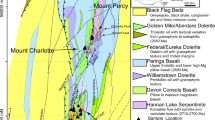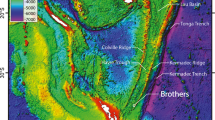Abstract
We present the first sulfur (S) isotope data of sulfides, sulfates, pyrite in host mudstone, and bulk sulfur of gabbroic rocks from the Laloki and Federal Flag massive Cu–Zn–Au–Ag deposits in the Astrolabe mineral district, Papua New Guinea. Early-stage pyrite–marcasite, chalcopyrite, and sphalerite from Laloki display wide range of δ34S values from −4.5 to +7.0 ‰ (n = 16). Late-stage pyrite, chalcopyrite, and sphalerite have restricted δ34S values of −1.9 to +4.7 ‰ (n = 16). The mineralizing stage these correspond to had moderately saline (5.9–8.4 NaCl eq. wt%) mineralizing fluids of possible magmatic origin. A single analysis of late-stage barite has a value of δ34S +17.9 ‰, which is likely similar to coexisting seawater sulfate. Pyrite from the foot-wall mudstone at Laloki has very light δ34S values of −36.1 to −33.8 ‰ (n = 2), which suggest an organic source for S. Pyrite–marcasite and chalcopyrite from Federal Flag show δ34S values of −2.4 to −1.9 ‰ (n = 2), consistent with a magmatic origin, either leached from intrusive magmatic rocks or derived from magmatic–hydrothermal fluids. The very narrow range and near-zero δ34S values (−1.0 to +0.6 ‰) of bulk gabbroic samples is consistent with mantle-derived magmatic S. Sulfur isotope characteristics of sulfides and sulfates are, however, very similar to base metal sulfide accumulations associated with modern volcanic arcs and sedimented mid-ocean ridges. The most reasonable interpretation is that the range of the sulfide and sulfate δ34S values from both Laloki and Federal Flag massive sulfide deposits is indicative of the complex interaction of magmatic fluids, seawater, gabbroic rocks, and mudstone.




Similar content being viewed by others
References
Alt JC, Anderson TF (1991) Mineralogy and isotopic composition of sulfur in layer 3 gabbros from the Indian Ocean, Hole 735B. In: Von Herzen RP, Robinson PT (eds) Proceedings of the Ocean Drilling Program, Scientific Results 118:113–124
Alt JC, Shanks WC (2003) Serpentinization of abyssal peridotites from the MARK area, Mid-Atlantic Ridge: sulfur geochemistry and reaction modeling. Geochim Cosmochim Acta 67:641–653
Arribas A Jr (1995) Characteristics of high-sulfidation epithermal deposits, and their relation to magmatic fluid. In: Thompson JFH (ed) In magmas, fluids, and ore deposits. Mineral Assoc Can Short Course 23:419–454
Bailie R, Gutzmer J, Strauss H, Stüeken E, McClung C (2010) Sulfur isotope characteristics of metamorphosed Zn–Cu volcanogenic massive sulfides in the Areachap Group, Northern Cape Province, South Africa. Miner Depos 45:481–496
Barley ME, Groves DI (1990) Deciphering the tectonic evolution of Archaean greenstone belts; the importance of contrasting histories to the distribution of mineralization in the Yilgarn Craton, Western Australia. Precambrian Res 46:3–20
Belogub EV, Novoselov KA, Yakovleva VA, Spiro B (2008) Supergene sulphides and related minerals in the supergene profiles of VHMS deposits from the South Urals. Ore Geol Rev 33:239–254
Bodnar RJ, Bethke PM (1984) Systematics of stretching of fluid inclusions I: fluorite and sphalerite at 1 atmosphere confining pressure. Econ Geol 79:141–161
Canfield DE, Oleson CA, Cox RP (2006) Temperature and its control of isotopic fractionation by sulfate-reducing bacterium. Geochim Cosmochim Acta 70:548–561
Chang Z, Large RR, Maslennikov V (2008) Sulfur isotopes in sediment-hosted orogenic gold deposits: evidence for an early timing and seawater sulfur source. Geology 12:971–974
Craddock PR, Bach W (2010) Insights to magmatic–hydrothermal processes in the Manus back-arc basin as recorded by anhydrite. Geochim Cosmochim Acta 74:5514–5536
de Ronde CEJ, Hannington MD, Stoffers P, Wright IC, Ditchburn RG, Reyes AG, Baker ET, Massoth GJ, Lupton JE, Walker SL, Greene RR, Soong CWR, Ishibashi J, Lebon GT, Bray CJ, Resing JA (2005) Evolution of a submarine magmatic-hydrothermal system: Brothers volcano, southern Kermadec arc, New Zealand. Econ Geol 100:1097–1133
Delacour A, Früh-Green GL, Bernasconi SM (2008) Sulfur mineralogy and geochemistry of serpentinites and gabbros of the Atlantis Massif (IODP Site U1309). Geochim Cosmochim Acta 72:5111–5127
Erickson KL, Macko SA, Van Dover CL (2009) Evidence for a chemoautotrophically based food web at inactive hydrothermal vents (Manus Basin). Deep-Sea Res II 56:1577–1585
Gemmell JB, Sharpe R, Jonasson IR, Herzig PM (2004) Sulfur isotope evidence for magmatic contributions to submarine and subaerial gold mineralization: Conical Seamount and the Ladolam gold deposit, Papua New Guinea. Econ Geol 99:1711–1725
Goodfellow WD, Lydon JW, Turner RJW (1993) Geology and genesis of stratiform sediment-hosted (SEDEX) zinc-lead-silver sulphide deposits. In: Kirkham RV, Sinclair WD, Thorpe RI, Duke JM (eds) Mineral deposit modelling. Geol Assoc Can Spec Pap 40:201–251
Habicht KS, Gade M, Thamdrup B, Berg P, Canfield DE (2002) Calibration of sulfate levels in the Archean Ocean. Science 298:2372–2374
Herzig PM, Petersen S, Hannington MD (1998) Geochemistry and sulfur-isotopic composition of the TAG hydrothermal mound, mid-Atlantic Ridge, 26°N. In: Herzig PM, Humphris SE, Miller DJ, Zierenberg RA (eds) Proceedings of the Ocean Drilling Program, Scientific Results 158:47–70
Hill KC, Hall R (2003) Mesozoic–Cenozoic evolution of Australia’s New Guinea margin in a west Pacific context. Geol Soc Aust Spec Publ 22 and Geol Soc Am Spec Pap 372:265–289
Huston DL (1999) Stable isotopes and their significance for understanding the genesis of volcanic-hosted massive sulfide deposits: a review. In: Barrie CT, Hannington MD (eds) Volcanic-associated massive sulfide deposits: processes and examples in modern and ancient settings. Rev Econ Geol 8:157–179
Huston DL, Relvas JMRS, Gemmell JB, Drieberg S (2011) The role of granites in volcanic-hosted massive sulphide ore-forming systems: an assessment of magmatic–hydrothermal contributions. Miner Depos 46:473–507
Kajiwara Y, Date J (1971) Sulfur isotope study of Kuroko-type and Kieslager-type strata-bound massive sulfide deposits in Japan. Geochem J 5:133–150
Kakegawa T, Utsumi M, Marumo K (2008) Geochemistry of sulfide chimneys and basement pillow lavas at the southern Mariana Trough (12.55°N–12.58°N). Resour Geol 58:249–266
Kim J, Lee I, Lee K-Y (2004) S, Sr, and Pb isotopic systematics of hydrothermal chimney precipitates from the Eastern Manus Basin, western Pacific: evaluation of magmatic contribution to hydrothermal system. J Geophys Res. doi:10.1029/2003JB002912
Kulange JB, Kajiwara Y, Komuro K (2002) Cu–Fe bearing zinc sulfide from Laloki stratabound massive sulfide deposit, Papua New Guinea: chemical characterization. Resour Geol 52:67–72
Kusakabe M, Komoda Y, Takano B, Abiko T (2000) Sulfur isotopic effects in the disproportionation reaction of sulfur dioxide in hydrothermal fluids: implications for the δ34S variations of dissolved bisulfate and elemental sulfur from active crater lakes. J Volcanol Geotherm Res 97(1–4):287–307
Large DE (1980) Geological parameters associated with sediment-hosted, submarine exhalative Pb-Zn deposits: an empirical model for mineral exploration. Geol Jahrb 40:59–129
Machel HG, Krouse HR, Sassen R (1995) Products and distinguishing criteria of bacterial and thermochemical sulfate reduction. Appl Geochem 10:373–389
Noku SK (2010) The Laloki strata-bound massive sulfide deposit, Papua New Guinea: geochemical, mineralogical, sulfur isotope and fluid inclusion characteristics. PhD thesis, Hokkaido University, Japan
Noku SK, Matsueda H, Akasaka M, Espi JO (2009) The Laloki massive sulfide strata-bound deposit, Papua New Guinea: geology, mineralogy and geochemistry. In: Williams PJ et al. (eds) Smart Science for Exploration and Mining. 10th Biennial SGA Meeting, Special Vol. 2. Springer, Townsville, Qld, 17–20 August 2009, Berlin, 731–733
Noku SK, Matsueda H, Espi JO, Akasaka M (2012) Petrology, geochemistry, and fluid inclusion microthermometry of sphalerite from the Laloki and Federal Flag strata-bound massive sulfide deposits, Papua New Guinea: implications for gold mineralization. Resour Geol 62:187–207
Ohmoto H (1986) Stable isotope chemistry of ore deposits. In: Valley JW, Taylor HP, O’Neil JR (eds) Stable isotopes in high temperature geological processes. Mineral Soc Am Rev Mineral 16:491–559
Ohmoto H, Goldhaber MB (1997) Sulfur and carbon isotopes. In: Barnes HL (ed) Geochemistry of hydrothermal ore deposits, 3rd edn. John Wiley, New York, pp 517–611
Ohmoto H, Lasaga AC (1982) Kinetics of reactions between aqueous sulfates and sulfides in hydrothermal systems. Geochim Cosmochim Acta 46:1727–1745
Paytan A, Gray ET, Ma Z, Erhardt A, Faul K (2011) Application of sulphur isotopes for stratigraphic correlation. Isot Environ Health Stud. doi:10.1080/10256016.2011.625423
Peters M, Strauss H, Farquhar J, Ockert C, Eickmann B, Jost CL (2010) Sulfur cycling at the mid-Atlantic Ridge: a multiple sulfur isotope approach. Chem Geol 269:180–196
Pontifex IR (1965) Mineralogical investigation of ore specimen from the Astrolabe Mineral Field. Papua, Aust Bur Mineral Resour Report, 1965/132
Rees CE, Jenkyns HC, Monster J (1978) The sulphur isotopic composition of ocean water sulphate. Geochim Cosmochim Acta 42:377–382
Rogerson RJ, Haig DW, Nion STS (1981) Geology of Port Moresby. Geol Surv PNG Report 81/16
Sakai H, Des Marais DJ, Ueda A, Moore JG (1984) Concentrations and isotope ratios of carbon, nitrogen and sulfur in ocean-floor basalts. Geochim Cosmochim Acta 48:2433–2441
Sangster DF (1968) Relative sulfur isotope abundances of ancient seas and strata-bound sulfide deposits. Geol Assoc Can Proc 19:79–91
Sangster AL (1992) Light stable isotope evidence for a metamorphogenic orogen for bedding parallel, gold-bearing veins in Cambrian flysch, Meguma Group, Nova Scotia. Explor Min Geol 1:69–79
Seal RR II (2006) Sulfur isotope geochemistry of sulfide minerals. Rev Mineral Geochem 61:633–677
Shanks WC III (2001) Stable isotopes in seafloor hydrothermal systems: vent fluids, hydrothermal deposits, hydrothermal alteration and microbial process. Rev Mineral Geochem 43:469–525
Shedden SH (1990) Astrolabe mineral field. In: Hughes FE (ed) Geology of the mineral deposits of Australia and Papua New Guinea. Victoria, Australian Institute of Mining Metallurgy, Melbourne, pp 1707–1708
Stetter KO (1996) Hyperthermophilic prokaryotes. FEMS Microbiol Rev 18:149–158
Williamson A (1982) Reappraisal of the astrolabe mineral field. Geol Surv PNG Report 82/25
Yamanaka T, Mizota C, Fujiwara Y, Chiba H, Hashimoto J, Gamo T, Okudaira T (2003) Sulphur-isotopic composition of the deep-sea mussel Bathymodiolus marisindicus from currently active hydrothermal vents in the Indian Ocean. J Mar Biol Assoc UK 83:841–848
Yates KR, de Ferranti RZ (1967) Geology and mineral deposits, Port Moresby/Kemp Welsh area. Papua, Aust Bur Mineral Resour Geol Geophys Report, 105
Acknowledgments
The research has been supported by the Japanese Ministry of Education, Science, and Technology. Field work was made possible through funding from the Society of Resource Geology to S. K. Noku. We thanked Mackenzie Baloiloi (Earth Sciences Division, University of Papua New Guinea) and James Kur (Morobe Mining Joint Venture) who assisted during the field work. We are grateful to D. L. Huston for his invaluable comments on the earlier draft of this paper.
Author information
Authors and Affiliations
Corresponding author
Additional information
Editorial handling: D. Huston
Rights and permissions
About this article
Cite this article
Noku, S.K., Espi, J.O. & Matsueda, H. Involvement of magmatic fluids at the Laloki and Federal Flag massive sulfide Cu–Zn–Au–Ag deposits, Astrolabe mineral district, Papua New Guinea: sulfur isotope evidence. Miner Deposita 50, 55–64 (2015). https://doi.org/10.1007/s00126-014-0563-y
Received:
Accepted:
Published:
Issue Date:
DOI: https://doi.org/10.1007/s00126-014-0563-y




